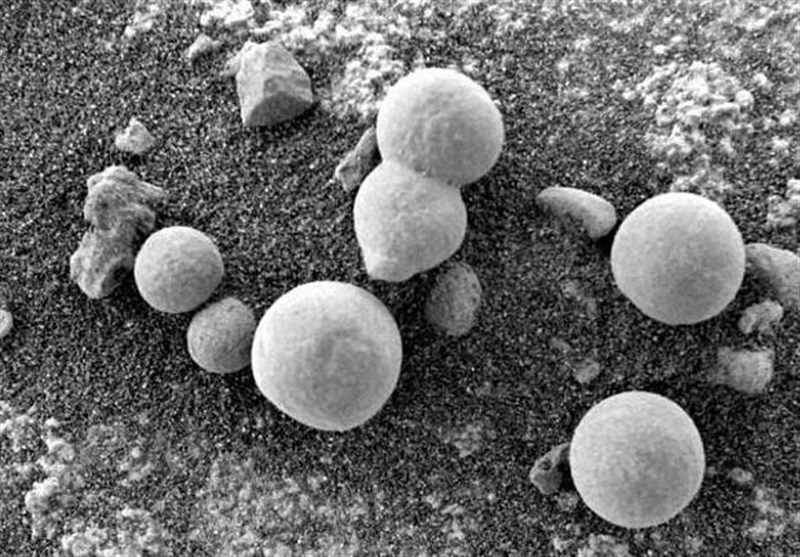Scientists Find Evidence of Mushrooms Growing on Mars
TEHRAN (Tasnim) - Images from the surface of Mars reveal the presence of mushrooms, a group of scientists claimed in a controversial new study.
In the controversial study, the alien life-hunters say they have seen what appeared to be algae, lichens and ‘Martian mushrooms’ in images taken by NASA rovers Opportunity and Curiosity from the surface of the supposedly barren planet.
NASA has not confirmed or denied that the conclusions drawn by the Journal of Astrobiology and Space Science have any scientific merit, The Sun reported.
Many scientists believe that Mars is the currently the only planet in the Solar System which has a strong possibility of containing life.
But the consensus in the scientific community is that if there is life on Mars, it’s believed to be below the surface.
The new study claims that 15 fungi specimens were photographed by NASA growing out of the ground on the red planet in just three days.
Dr Regina Dass, of the Department of Microbiology, School of Life Sciences, India, claims that the photos do not show any fungi species that grow on Earth.
“There are no geological or other abiogenic forces on Earth which can produce sedimentary structures, by the hundreds, which have mushroom shapes, stems, stalks, and shed what looks like spores on the surrounding surface,” Dr Dass said.
“In fact, fifteen specimens were photographed by NASA growing out of the ground in just three days.”
The report cited previous studies that suggest a variety of species, including bacteria, algae, fungi and lichens, can survive a simulated Mars-like environment.
Dr Vincenzo Rizzo, a National Research Council biogeologist, also pointed to the seasonal fluctuations in Martian methane as additional evidence of life.
He said: “As we detail in our article, 90 per cent of terrestrial methane is biological in origin and seasonal fluctuations in atmospheric methane are directly correlated with plant growth and death cycles.
“The cyclic fluctuations in Martian methane is reflective of active biology which is also depicted in before and after pictures of specimens photographed by NASA."
CONTROVERSIAL STUDY
The controversial study was subjected to extensive peer review by six independent scientists and eight senior editors.
And while three of these rejected the evidence, the remaining eleven recommended publication, after certain revisions.
Other academics proposed an alternative explanation and say it is more feasible the specimens are hematite, a form of iron oxide.
The journal stated: “Evidence is not proof and there is no proof of life on Mars.
“Abiogenic explanations for this evidence can't be ruled out.”
Some scientists believe the specimens photographed emerging from beneath the Martian soil, are not mushrooms but hematite, a form of iron oxide.
Dr Rizzo said: “We are not disagreeing with NASA. NASA has some of the greatest scientists and engineers in the world.
"However, hematite is also a product of biological activity.”
LIFE ON MARS?
An ancient underground system of lakes on Mars could also suggest there was once life on the red planet.
Scientists used information from the European Space Agency (ESA) to locate the lost waterways, giving them new hope in the search for alien life.
Previously, the underground water networks had only been predicted by computer models.
Information from the ESA’s Mars Express mission, which was launched in 2003, has suggested that there were once large bodies of water above and below ground on the planet.
Scientists have been predicting that Mars used to contain water for almost a decade but, until now, they have never been sure where it was located.
Utrecht University geologist Francesco Salese used satellite images from the ESA Mars Mission orbiter to study 24 low-lying areas located on the northern hemisphere of Mars.
He also found evidence of ancient dried up rivers and coastlines.
He said: "These are strong indications that water was once present in these dried-up basins. There is no evidence that they had been filled from the surface, so up-welling ground water is the only remaining explanation. The deltas are all located at approximately the same elevation, so we are probably dealing with a ground water reservoir that spans the entire planet.”
The big question now is what happened to these ancient water systems and whether the same could happen to Earth.
Salese added: "As we learn more about water on Mars, especially the reason why we see so little of it on the planet today, we may be able to find out if the same can happen to Earth, or if it had already happened when Earth was still very young.”
In 2020, the ESA will collaborate with Russian space agency Roscosmos to launch the ExoMars rover with the aim of searching for aliens on the Mars’s surface.






